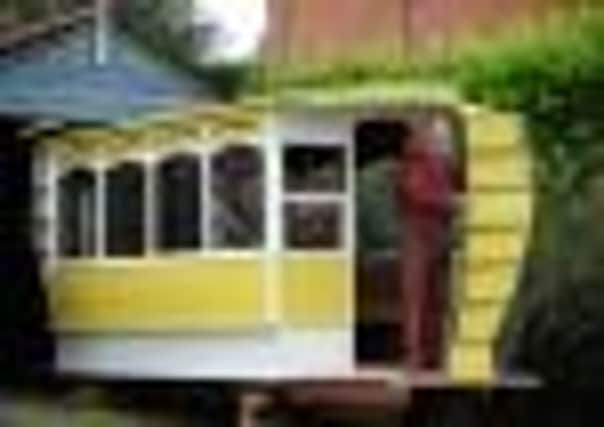Tram plan back on track after 35 years in a garage


Yesterday, almost four decades after it was pushed into a dusty garage workshop at Whitkirk in Leeds, it emerged into the sunshine to gasps of admiration from assembled tram enthusiasts and neighbours who often wondered over the years when it would be finished.
That moment won’t come for another year but yesterday marked an important milestone as the body of the vehicle – a former horse-drawn, double-deck passenger tram – was taken by lorry to a bigger workshop where its upper passenger deck seats and wheels can finally be fitted.
Advertisement
Hide AdAdvertisement
Hide AdIt was a proud moment for the perfectionists of the Leeds Transport Historical Society and the handful of stalwarts who finally made the long-running restoration project happen.
The group helped to raise every penny of the £35,000 spent so far and members have ensured every part of the tram is as close to its original as possible.
Project manager Jamie Guest, a retired West Yorkshire policeman, said the tram had gone into the garage in 1977 but members had only begun work on it seven years ago – and then only on Wednesdays.
“It has finally outgrown the garage because we cannot put the chassis under it.
Advertisement
Hide AdAdvertisement
Hide Ad“When the chassis is on it will be able to move on rails for the first time since 1901.”
The 20ft-long, 7ft high tram went out of service in the year of Queen Victoria’s death having taken up to 34 passengers a time (18 upstairs, 16 down) along the Leeds tramways.
Later, it was used as a workmen’s hut and then as a summerhouse in a garden in East End Park, Leeds.
Its next stop is a workshop at the Middleton Railway in Leeds.
Advertisement
Hide AdAdvertisement
Hide AdMr Guest is hopeful that by early 2014 it will be taking passengers again at the Crich Tramway Village in Derbyshire.
He is proud the restoration has taken so long as it has meant that every nut, bolt and piece of wood could be researched and sourced to ensure the finished vehicle is perfect.
Watching yesterday’s grand exit from the garage was widow Margaret Donald, whose late husband Bernard worked on the project in his garage until his death in 2010.
Mrs Donald, now living in York, said: “It was my husband’s dream to see it restored, I wish he could be here to see it.
Advertisement
Hide AdAdvertisement
Hide Ad“He was the supervisor who did all the calculations and plans.”
The couple’s daughter Christine Clark also travelled down from York to the Whitkirk home where she lived in the 1970s.
“I was seven when it went in the garage,” she said. “This is quite an emotional day.
“They have worked very hard on it – there is no heating in the garage.
Advertisement
Hide AdAdvertisement
Hide Ad“My dad was a ‘measure twice, cut once’ kind of chap. I used to gaze at the tram through the garage window when I was little.”
Andrew Bailey, an engineer at the Crich tramway, was also on hand to witness the tram leave its garage home. He praised the tram enthusiasts’ attention to detail, saying: “They have done a very good job. They have had to learn new skills, a lot of new skills.”
He said some tram restorers were happy to cut corners by using modern items such as screws – but not the 107 men.
Mr Guest’s policing skills helped him in researching the design of the tram as no plans exist.
Advertisement
Hide AdAdvertisement
Hide AdHe also had to find engineering companies in Yorkshire who were capable and willing to use old-fashioned methods to produce the metalwork.
“The wheels were cast in Huddersfield by H Downs and Sons; probably the first ‘chilled iron’ to be cast in Britain for decades. The axles were forged in Sheffield, the brakes in Halifax and fabrications in Batley. It is all bespoke – the patterns alone cost £7,000.
“The windows, which have to conform to modern safety standards were manufactured and supplied by Oakland Glass of Dewsbury and Cyril Isaacs and Co of Dewsbury Road, Leeds at no cost; we are very grateful for this sponsorship.
“We believe we have the only restored tram in Britain, possibly he world, which has had its running gear built from scratch.”
Advertisement
Hide AdAdvertisement
Hide AdNeighbours came out of their houses yesterday to wave it off.
Margaret Capitano said: “They come every Wednesday and I will miss them when they have gone.”
Retired joiner Paul Brearley, a stalwart of the restoration group, said: “It languished in the shed for years but when we went to see it we knew it could be restored. None of it has been easy. It has taken a tremendous amount of research on the specifications for the missing parts like the chassis.”
Group treasurer Tony Cowell said: “Personally, I didn’t think it was possible. I didn’t realise all these small engineering firms existed.”